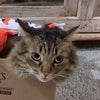It fits!
Pardon the brim remnants. Not pictured: the many prior iterations. This started as a head on photo that I imported into fusion 360 and scaled after some measuring with calipers. It’s not perfect, but it’s rapidly approaching good enough. The square indent is to help with orientation - although the part obviously is not symmetrical, it’s much harder to judge the home.




Add comment